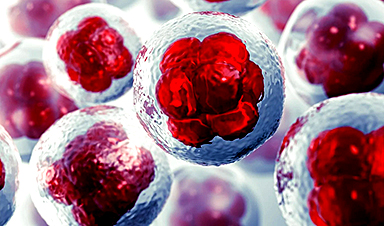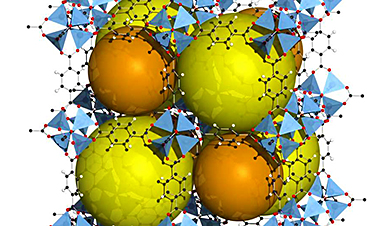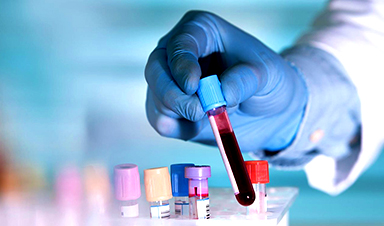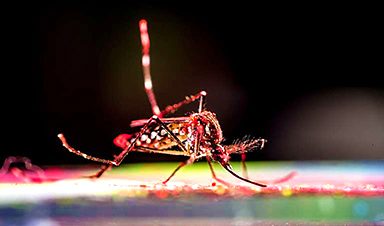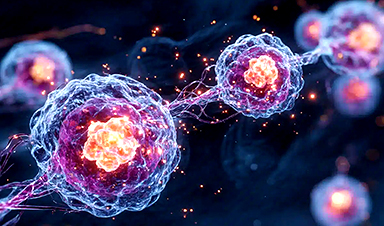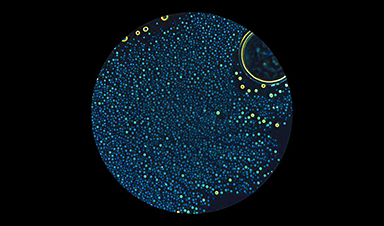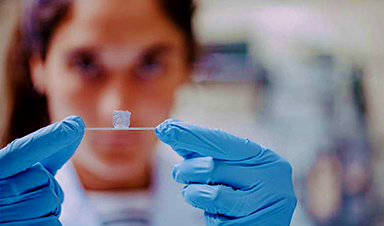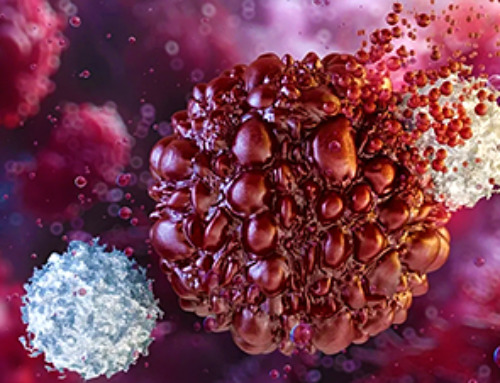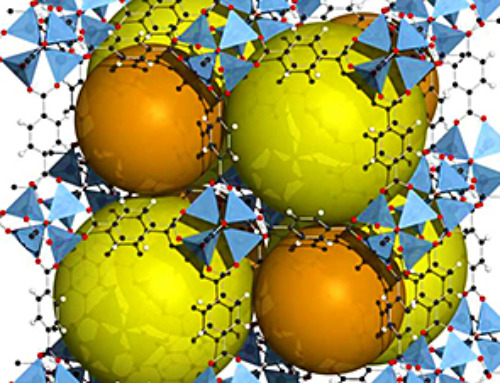IST's new infrared microscopy technique allows for the detailed imaging of biomolecules in cells, supporting advancements in biotechnology and cellular therapies.
In an effort to advance biotechnology innovations, scientists are working to develop faster, more quantitative, and more accessible ways to observe biomolecules in living cells.
Now, researchers at the National Institute of Standards and Technology (NIST) have developed a new method that allows the use of infrared (IR) light to capture clear images of biomolecules inside cells, something that was previously not possible due to the tendency of the water in cells to absorb infrared radiation.
NIST's new method removes the obscuring effects of water in IR-based measurements and allows researchers to determine the amounts of key biomolecules in cells, such as the proteins that direct cell function. The ability to measure changes in living cells could speed up advances in biomanufacturing, cell therapy development, drug development, and more.
Their findings have been published in Analytical Chemistry.

Understanding Infrared Microscopy and Its Challenges
Infrared radiation is light that is just beyond what is visible to the human eye. Although we cannot see IR light, we can feel it as heat. In IR microscopy, a material of interest absorbs radiation from a range of wavelengths in the IR spectrum. Scientists measure and analyze the IR absorption spectrum of a sample, producing a set of "fingerprints" to identify molecules and other chemical structures. However, water, the most abundant molecule both inside and outside cells, absorbs infrared strongly and masks the infrared absorption from other biomolecules in cells.
One way to understand this optical masking effect is to compare it to when an airplane passes overhead next to the Sun. With the naked eye, it's hard to see the airplane because of the Sun, but if you use a special Sun-blocking filter, then you can easily see the airplane in the sky.
"In the spectrum, water absorbs infrared so strongly, and we want to see the absorption spectrum of proteins through the thick water background, so we designed the optical system to uncloak the water contribution and reveal the protein signals," said NIST chemist Young Jong Lee.
Advancing Cellular Analysis with SAC-IR
Lee developed a patented technique that uses an optical element to compensate for water absorption from IR. Called solvent absorption compensation (SAC), the technique was used with a hand-built IR laser microscope to image cells that support the formation of connective tissue, called fibroblast cells. Over a 12-hour observation period, researchers were able to identify groups of biomolecules (proteins, lipids, and nucleic acids) during stages of the cell cycle, such as cell division. While this may seem like a long time, the method is ultimately faster than current alternatives, which require beam time at a large synchrotron facility.
This new method, called SAC-IR, is label-free, meaning it does not require any dyes or fluorescent markers, which can harm cells and also produce less consistent results across labs.
The SAC-IR method enabled NIST researchers to measure the absolute mass of proteins in a cell, in addition to nucleic acids, lipids, and carbohydrates. The technique could help establish a foundation for standardizing methods for measuring biomolecules in cells, which could prove useful in biology, medicine, and biotechnology.
"In cancer cell therapy, for example, when cells from a patient's immune system are modified to better recognize and kill cancer cells before being reintroduced back to the patient, one must ask, 'Are these cells safe and effective?' Our method can be helpful by providing additional insight with respect to biomolecular changes in the cells to assess cell health," said Lee.
Other potential applications include using cells for drug screening, either in the discovery of new drugs or in understanding the safety and efficacy of a drug candidate. For example, this method could help to assess the potency of new drugs by measuring absolute concentrations of various biomolecules in a large number of individual cells or to analyze how different types of cells react to the drugs.
Future Applications and Improvements
The researchers hope to develop the technique further so it can measure other key biomolecules, such as DNA and RNA, with greater accuracy. The technique could also help provide detailed answers to fundamental questions in cell biology, such as what biomolecule signatures correspond with cell viability — in other words if the cell is alive, dying, or dead.
"Some cells are preserved in a frozen state for months or years, then thawed for later use. We don't yet fully understand how best to thaw the cells while maintaining maximum viability. With our new measurement capabilities, we may be able to develop better processes for cell freezing and thawing by looking at their infrared spectra," said Lee.
Reference: "Benchtop IR Imaging of Live Cells: Monitoring the Total Mass of Biomolecules in Single Cells" by Yow-Ren Chang, Seong-Min Kim and Young Jong Lee, 4 September 2024, Analytical Chemistry.
DOI: 10.1021/acs.analchem.4c02108
News
Study Delivers Cancer Drugs Directly to the Tumor Nucleus
A new peptide-based nanotube treatment sneaks chemo into drug-resistant cancer cells, providing a unique workaround to one of oncology’s toughest hurdles. CiQUS researchers have developed a novel molecular strategy that allows a chemotherapy drug to [...]
Scientists Begin $14.2 Million Project To Decode the Body’s “Hidden Sixth Sense”
An NIH-supported initiative seeks to unravel how the nervous system tracks and regulates the body’s internal organs. How does your brain recognize when it’s time to take a breath, when your blood pressure has [...]
Scientists Discover a New Form of Ice That Shouldn’t Exist
Researchers at the European XFEL and DESY are investigating unusual forms of ice that can exist at room temperature when subjected to extreme pressure. Ice comes in many forms, even when made of nothing but water [...]
Nobel-winning, tiny ‘sponge crystals’ with an astonishing amount of inner space
The 2025 Nobel Prize in chemistry was awarded to Richard Robson, Susumu Kitagawa and Omar Yaghi on Oct. 8, 2025, for the development of metal-organic frameworks, or MOFs, which are tunable crystal structures with extremely [...]
Harnessing Green-Synthesized Nanoparticles for Water Purification
A new review reveals how plant- and microbe-derived nanoparticles can power next-gen water disinfection, delivering cleaner, safer water without the environmental cost of traditional treatments. A recent review published in Nanomaterials highlights the potential of green-synthesized nanomaterials (GSNMs) in [...]
Brainstem damage found to be behind long-lasting effects of severe Covid-19
Damage to the brainstem - the brain's 'control center' - is behind long-lasting physical and psychiatric effects of severe Covid-19 infection, a study suggests. Using ultra-high-resolution scanners that can see the living brain in [...]
CT scan changes over one year predict outcomes in fibrotic lung disease
Researchers at National Jewish Health have shown that subtle increases in lung scarring, detected by an artificial intelligence-based tool on CT scans taken one year apart, are associated with disease progression and survival in [...]
AI Spots Hidden Signs of Disease Before Symptoms Appear
Researchers suggest that examining the inner workings of cells more closely could help physicians detect diseases earlier and more accurately match patients with effective therapies. Researchers at McGill University have created an artificial intelligence tool capable of uncovering [...]
Breakthrough Blood Test Detects Head and Neck Cancer up to 10 Years Before Symptoms
Mass General Brigham’s HPV-DeepSeek test enables much earlier cancer detection through a blood sample, creating a new opportunity for screening HPV-related head and neck cancers. Human papillomavirus (HPV) is responsible for about 70% of [...]
Study of 86 chikungunya outbreaks reveals unpredictability in size and severity
The symptoms come on quickly—acute fever, followed by debilitating joint pain that can last for months. Though rarely fatal, the chikungunya virus, a mosquito-borne illness, can be particularly severe for high-risk individuals, including newborns and older [...]
Tiny Fat Messengers May Link Obesity to Alzheimer’s Plaque Buildup
Summary: A groundbreaking study reveals how obesity may drive Alzheimer’s disease through tiny messengers called extracellular vesicles released from fat tissue. These vesicles carry lipids that alter how quickly amyloid-β plaques form, a hallmark of [...]
Ozone exposure weakens lung function and reshapes the oral microbiome
Scientists reveal that short-term ozone inhalation doesn’t just harm the lungs; it reshapes the microbes in your mouth, with men facing the greatest risks. Ozone is a toxic environmental pollutant with wide-ranging effects on [...]
New study reveals molecular basis of Long COVID brain fog
Even though many years have passed since the start of the COVID-19 pandemic, the effects of infection with SARS-CoV-2 are not completely understood. This is especially true for Long COVID, a chronic condition that [...]
Scientists make huge Parkinson’s breakthrough as they discover ‘protein trigger’
Scientists have, for the first time, directly visualised the protein clusters in the brain believed to trigger Parkinson's disease, bringing them one step closer to potential treatments. Parkinson's is a progressive incurable neurological disorder [...]
Alpha amino acids’ stability may explain their role as early life’s protein building blocks
A new study from the Hebrew University of Jerusalem published in the Proceedings of the National Academy of Sciences sheds light on one of life's greatest mysteries: why biology is based on a very specific set [...]
3D bioprinting advances enable creation of artificial blood vessels with layered structures
To explore possible treatments for various diseases, either animal models or human cell cultures are usually used first; however, animal models do not always mimic human diseases well, and cultures are far removed [...]
